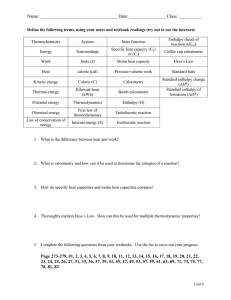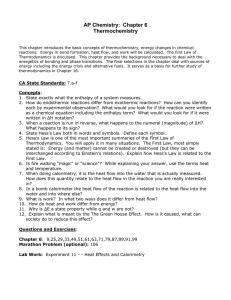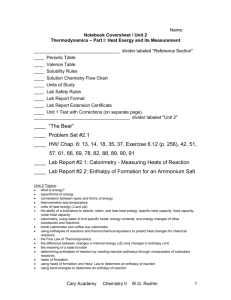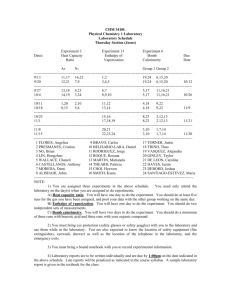Reading Guide Chapter 5 Section 5.1 The Nature of Energy Define
advertisement
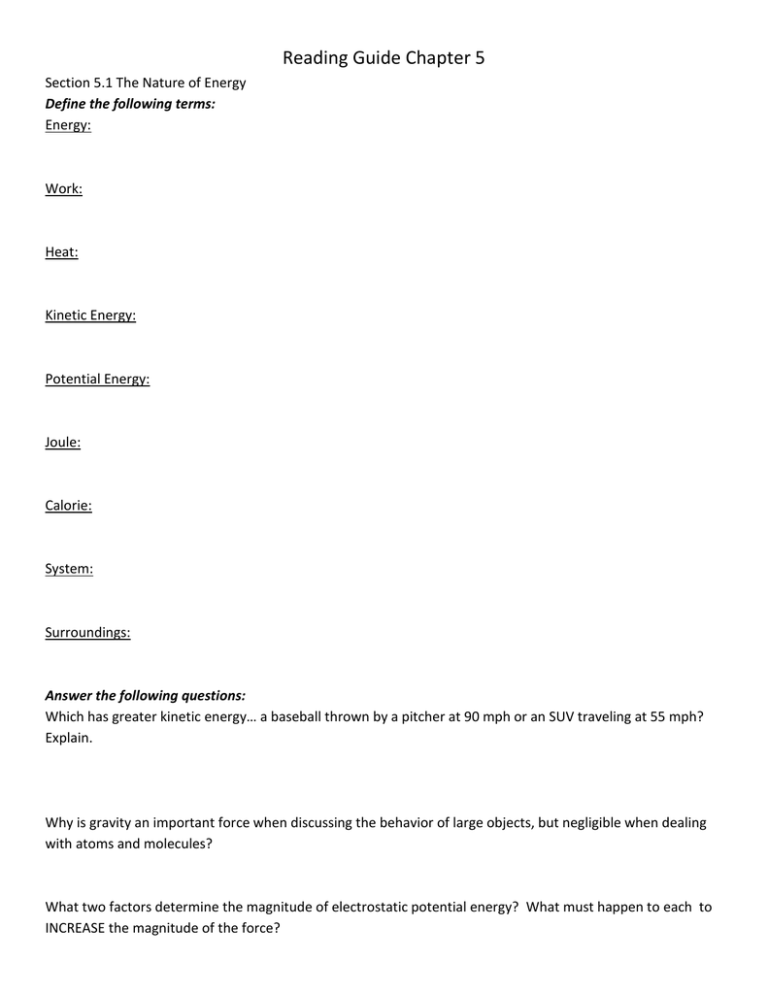
Reading Guide Chapter 5 Section 5.1 The Nature of Energy Define the following terms: Energy: Work: Heat: Kinetic Energy: Potential Energy: Joule: Calorie: System: Surroundings: Answer the following questions: Which has greater kinetic energy… a baseball thrown by a pitcher at 90 mph or an SUV traveling at 55 mph? Explain. Why is gravity an important force when discussing the behavior of large objects, but negligible when dealing with atoms and molecules? What two factors determine the magnitude of electrostatic potential energy? What must happen to each to INCREASE the magnitude of the force? Explain, in terms of energy, the difference between an open system and a closed system. What is meant by an isolated system? State the difference two ways that energy may be transferred. Section 5.2 The First Law of Thermodynamics Define the following terms: Internal Energy: Endothermic: Exothermic: State Function: Answer the following questions: State the First Law of Thermodynamics. What is ΔE? What does the sign (+ or -) indicate about ΔE? How is an increase in internal energy indicated by an energy diagram? What are the sign conventions for q and w and what do they mean? Why is ΔE considered to be a state function? Section 5.3 Enthalpy Define the following terms: Pressure-volume work: Enthalpy: Answer the following questions: When an expanding gas causes a piston to move upward, increasing the volume of the gas, why is the sign of w negative? What is the difference between ΔE and ΔH? What is qp and how is it related to ΔH? What does the sign of ΔH tell us about a reaction? Section 5.4 Enthalpies of Reaction Define the following terms: Enthalpy of reaction: (include equation) Thermochemical equations Enthalpy diagram: (draw the example in the text) Answer the following questions: What does it mean to say that enthalpy is an extensive property? WHY is the enthalpy change for a reaction equal in magnitude, but opposite in sign to the enthalpy change for the reverse reaction? What state of matter has the greatest enthalpy? Section 5.5 Calorimetry Define the following terms: Calorimeter: Calorimetry: Heat Capacity: Molar Heat Capacity: Specific Heat: Bomb Calorimeter: Answer the following questions: If the specific heat capacity of a substance is known, how can the molar heat capacity be calculated? (For example, the specific heat capacity of water is 4.18 J/g·K….what is its molar heat capacity? Which substance in table 5.2 will lose heat most rapidly? What assumptions are made when measuring energy changes with a coffee-cup calorimeter? How is this different from bomb calorimetry? Look at the example of bomb calorimetry given in sample exercise 5.7. Now try the practice exercise here: Section 5.6 Hess’s Law State Hess’s Law: Draw the enthalpy diagram given as an example to illustrate Hess’ Law. Be sure that you can understand what the diagram demonstrates. How does Hess’s Law prove that enthalpy is a state function? Section 5.7 Enthalpies of Formation Define the following terms: Standard state: (define conditions) Standard Enthalpy of formation: Answer the following questions: Why is the ΔH°f for elements in their standard states equal to 0? How are the heats of formation used to find ΔH for a particular reaction? What role do the coefficients in an equation play in determining ΔH for a reaction using ΔH°f data? Explain. Look at Sample Exercise 5.10. Try the practice exercise.
